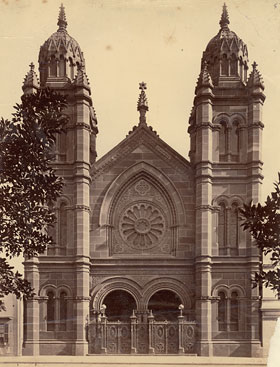The Great Synagogue, Sydney
In 1859, debate over the circumcision of the son of a non-Jewish mother caused a split within Sydney’s Jewish community. Many of the founders of the Sydney Synagogue broke away and established the Sydney New Synagogue in a former Baptist chapel on Macquarie Street.
The Sydney Synagogue continued at its York Street location, until the building could no longer house the growing Hebrew congregation. By that time, the Sydney New Synagogue was struggling financially. Both synagogues soon understood the futility of carrying on as separate congregations.
The Jewish Synagogue and Schools Act of 1872 gave the Sydney Synagogue permission to sell land it had previously been granted. This included land adjoining the York Street premises and a portion on Church Hill that had been designated for use as a school. The sales of these properties - and proceeds from the sale of properties bequeathed by congregation members Simon Lear and M. L. Jonas - aided in the building of new, enlarged premises that would become known as the Great Synagogue.
Thomas Rowe, a notable architect of Victorian-era Sydney, designed the iconic Great Synagogue building which was situated on an impressive block fronting both Castlereagh Street and Elizabeth Street, opposite Hyde Park.
On 26 January 1875, Sydney’s Jewish community gathered to celebrate the laying of the foundation stone by the Hon. (later Sir) Saul Samuel, then postmaster-general and later a president of the Great Synagogue, who gave a stirring speech and buried a time capsule.
One of the greatest contributions to the Great Synagogue's building fund was provided by the Hebrew Ladies’ Bazaar. In December 1875, the women of Sydney’s Jewish community staged a very successful 'sale of work or 'fancy fair' at which great quantities of handicrafts and gifts were sold to raise funds for the construction of the new synagogue.
Jews tend to live in close proximity to synagogues. As all forms of work are prohibited on Saturday, the Jewish Sabbath, most observant Jews see driving as a form of work and tend to live within walking distance of their local synagogue. Changes to Sydney’s demography throughout the 20th century saw Jewish communities established across Sydney’s spreading suburbs. Yet, despite such changes, the Great Synagogue remains a centre of Jewish religious life in Sydney, and a leading force among the synagogues of New South Wales to this day.
<View a selection of images of the Great Synagogue 
<Read about the laying of the foundation stone of the Great Synagogue in 1875
 The Great Synagogue Sydney, ca.1880,
The Great Synagogue Sydney, ca.1880,

